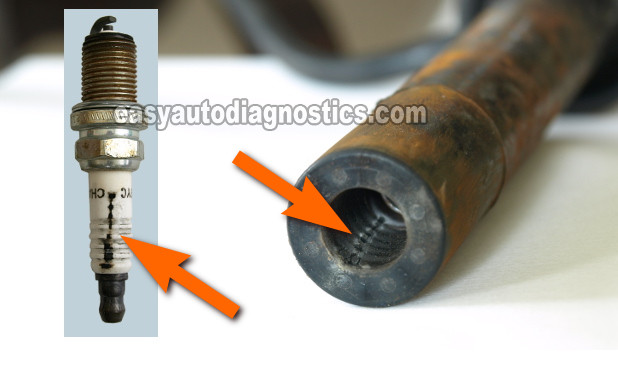TEST 7: The Power Transistor's Ground Circuit

For the power transistor (ignition control module), on your Nissan Altima, to activate the ignition coil, it has to have a good path to Ground and this test will help you to verify that it does.
For this test you can use a multimeter or a test light, although the test steps assume that you're using a multimeter:
- 1
Select Volts DC mode on your multimeter.
- 2
With the black multimeter test lead probe the wire identified with the number 2 in the photo above.
- 3
Connect the red multimeter test lead to the battery positive (+) terminal.
- 4
You should see 10 to 12 Volts on the multimeter without having to turn the key to the ON position. Do you have 12 Volts?
Let's interpret your test result:
CASE 1: Your multimeter displayed 10 to 12 Volts. This is good since it let's you know that the power transistor has a good path to Ground, the next step is to verify it's receiving a Triggering signal from the fuel injection computer. Go to: TEST 8: Testing The Triggering Signal from PCM.
CASE 2: Your multimeter DID NOT display 10 to 12 Volts. Then there's a problem with the Ground circuit. Without Ground the power transistor cannot activate the ignition coil to start sparking.
Resolving this Ground issue should solve your 'no-start no-spark' condition.
TEST 8: Testing The Triggering Signal From PCM

The fuel injection computer is the one that creates and feeds the power transistor (ignition control module) the Triggering signal on your Nissan Altima. As mentioned in the first part of this article, it's this Triggering signal that tells the power transistor the exact time to activate the ignition coil to spark.
In this test, you're gonna' check to see if the power transistor is being supplied with it when the engine is being cranked. For this test you'll need to use a multimeter that can read Hertz frequency. An LED light will not work here since the signal's frequency is so fast that you can not see it with an LED light.
NOTE: The battery must be fully charged for before attempting this test.
OK, let's get started:
- 1
Select Hertz (Hz) frequency mode on your multimeter.
Don't have a digital multimeter that can read Hertz frequency? See my recommendations here: Buying A Digital Multimeter For Automotive Diagnostic Testing. - 2
Connect the red multimeter test lead to the wire labeled with the number 1 in the photo.
- 3
The BLACK lead of the multimeter goes to the battery negative (-) terminal.
- 4
Have your helper crank the engine while you observe the multimeter.
- 5
Your multimeter will register around 6 to 8 Hertz (Hz) on its display screen as the engine is cranked.
Let's see what your test result means:
CASE 1: The multimeter registered 6 to 8 Hertz (Hz). This confirms that the power transistor is fried and needs to be replaced.
CASE 2: The multimeter DID NOT register 6 to 8 Hertz (Hz). Recheck all of your connections and repeat the test.
If still the multimeter does not register the indicated Hertz values, this indicates one of three things (as the possible causes of this missing signal): 1) A bad crank angle sensor or 2) an open in this circuit between the power transistor and the PCM or 3) a bad PCM, although this is rare.
Other Causes Of A Misfire

So you've done all of the spark tests, and still your Nissan Altima is running rough (rough idle) and/or the misfiring. Well, here are a couple of suggestions that might help:
- The valve cover gasket is leaking oil onto the spark plug wells (tubes) and soaking the spark plugs and spark plug wire boots in oil.
- Over time, this oil will cause a misfire as the oil cooks and turns into carbon tracks.
- The photos above shows you what a carbon track looks like on the inside of the spark plug wire boot and on the ceramic insulator of the spark plug.
- Engine compression test
- One of the most overlooked diagnostic tests to find the root cause of misfire is the compression test.
- You'll need an engine compression tester of course.
- The engine compression readings between cylinders should not vary more 15%.
- Carbon tracks on the spark plug(s) and in the inside of the spark plug wires.
- The the orange arrows in the photo above point to what carbon tracks look like.
- Replace the components as affected with carbon tracks.
- Broken spark plugs.
- This usually happens at tune-up time, if you have dropped one on the floor.
- You power washed the engine, this is something that should never be done on any Nissan vehicle.

If this info saved the day, buy me a beer!


